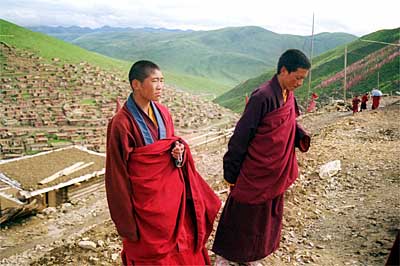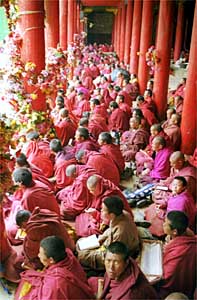July 28, 1999
A 'Living Buddha' Plants an Academy
By SETH FAISON
ERTHAR, China -- Nearly every day, Tibetan monks and nuns wearing blood-red robes arrive at this distant outpost after a long trek through a forbidding range of mountains. Drawn by word that a brilliant teacher resides here, they climb a twisting path up a narrow valley to find a freshly built metropolis of Buddhist worship. It is a stunning sight in an otherwise barren setting and a potent symbol of the revival in Tibetan Buddhism under way here. A vast assembly of log cabins, spartan inside and out, covers a pair of steep hillsides. At dusk, crowds of monks and nuns buzz in conversation, their hair shorn and their gazes serene, as they gather for evening prayers outside a ramshackle collection of meeting halls that are connected by a criss-cross of muddy pathways.

Two monks at the institute for Buddhist study at Serthar. It is prominent among Tibetan religious sites being built or rebuilt with private donations from Tibetans and reluctantly tolerated by the Chinese authorities.
In just a few years, Serthar has emerged to become one of the largest and most influential centers for the study of Tibetan Buddhism in the world. Despite its extremely remote location in an ethnic Tibetan region of Sichuan Province, more than 500 miles by dirt road from the nearest city, Serthar has attracted nearly 8,000 monks and nuns who now live and study here.Like countless sects of qigong, traditional meditative and physical exercises that have enjoyed popularity among Chinese who believe they can enhance vital energies, Tibetan Buddhism seems to be filling a spiritual void in the hearts of many adherents. (A new variant of qigong, Falun Gong, which has attracted a wide following, was banned on July 22 in a high-profile crackdown.)
Serthar is now the brightest star among a number of Tibetan Buddhist temples that are being built or rebuilt with private donations from Tibetans and reluctantly accepted by Chinese authorities. Economic growth has fattened the pockets of some Tibetans in recent years, and their generosity is funding a gradual replacement of the thousands of temples that were demolished by marauding Chinese leftists during the 1960s and 1970s.
Tibetans still bristle at the myriad restrictions by Chinese authorities on religious worship, both in Tibet proper and in the Tibetan-populated regions in adjoining provinces like this one. But at the same time that Chinese officials take steps to tighten control over large monasteries that are wellsprings of political dissent, Serthar is an example of how difficult it is for Chinese authorities to fully control places of worship where popular support is surging among the ordinary faithful.
At Serthar, set up as an institute for Buddhist study instead of as a monastery, the principal magnet is a master teacher, Khenpo Jikphun, known by followers as a "living buddha," and believed to be the reincarnation of a holy figure. Khenpo Jikphun, 66, set up the religious center here in 1980 in an entirely uninhabited valley. It began in a haphazard way, with a handful of disciples gathering around the modest home he lived in. Spreading word slowly attracted more followers, and in recent years, attendance has surged so fast that there is now a desperate shortage of living quarters.
Monks and nuns here say they were drawn by their teacher's reputation as a deeply insightful scholar who is devoted to reviving a rigorous study of Tibetan Buddhism that was devastated when monasteries were closed and monks defrocked in political campaigns directed by Chinese authorities. "We know our teacher is a great man," said Sonam, a 23-year-old nun, who arrived 18 months ago and who, like many Tibetans, uses only one name. "He has attained a higher level of knowledge than anyone in the nation, and what he cares most about is teaching."

A gathering at Serthar. Religious men and women have been drawn there by the presence of a teacher regarded as a "living buddha."
One of the most surprising elements of Serthar is that more than half of those who come to study are women. Entry is limited at the relatively small nunneries that exist in areas populated by Tibetans, but Serthar is open to virtually anyone who is a genuine student of Khenpo Jikphun's brand of Buddhism. Another surprise at Serthar is that it attracts ethnic Chinese students as well as Tibetans. Of the nearly 8,000 students here, roughly 800 are ethnic Chinese, who attend separate classes taught in Mandarin, while larger classes are taught in Tibetan.It costs nothing to study here, yet monks and nuns have to find their own housing. Wooden cabins are going up all over the place, but not fast enough to handle all the new arrivals. Nearly everyone at Serthar seems to credit Khenpo Jikphun's ingenuity with the spectacular growth here. Khenpo Jikphun maintains good ties with both Beijing and with the Dalai Lama, in part by discouraging political discussion and encouraging students to focus on Buddhist study alone. "Khenpo's revival of the devastated Tibetan Buddhist systems of educational training has been nothing short of remarkable," wrote David Germano, a Tibet scholar at the University of Virginia, in a recent essay about Serthar in which he argues that stressing ethics over political activism is a powerful model for survival in today's environment.
On top of the intellectual and religious vigor Khenpo Jikphun brought to Serthar is his mythic, and charismatic presence. Followers believe he is omniscient and say he was born with the ability to speak and recite scripture. He even emerged from his mother's womb, they say, with the placenta wrapped over his shoulder like a monastic robe. Khenpo Jikphun claims to be the reincarnation of a holy figure who taught the previous Dalai Lama, and who died early this century. Khenpo Jikphun's followers believe it gives him a special relationship with the current Dalai Lama, whom he visited in India in 1990.
Eager to keep up good relations with Chinese authorities, Khenpo Jikphun participates in an advisory committee in the local government. He often travels and even visited the United States in 1993. Khenpo Jikphun is extremely popular in the region. Beyond religious devotees, many ordinary residents in the area display his photograph next to the Dalai Lama's in stores, homes and even in the cabs of the hefty cargo trucks that traverse rutted mountain roads.
Khenpo Jikphun declined a request for an interview. One of his top lieutenants, Sudaji, said there had never been any serious political problems at Serthar, and pointed out that Khenpo Jikphun has never encouraged monks and nuns to come to Serthar but simply welcomed those who show up. Several monks here said that authorities in Beijing have expressed concern about the fast growth of the community at Serthar, apparently worried about the inherent threat posed by any organization they do not fully control. Yet suggestions that some of the new arrivals should be turned away and sent home have apparently been met by a gentle insistence from Khenpo Jikphun that it is not his role to police or discourage the faithful.
Enthusiastic monks and nuns here point to a rigorous curriculum of Buddhist study that encompasses a large body of texts in diverse genres that include painting, medicine, history and poetry, as well as philosophy. Yet they are also inspired by Khenpo Jikphun's personal example of strict celibacy and ethical norms as the best path to spiritual revitalization. Although many Tibetan religious leaders have been seduced by modern comforts, they say, Khenpo Jikphun has consistently criticized moral lapses among others, which has created a number of enemies among other Tibetan religious leaders.
"If everyone can learn from our teacher, there will be fewer problems in the world," said Tsering Gyaldyup, a monk who has studied here for eight years. "I want to stay here forever, because there is no better place to be."
Copyright 1999 The New York Times Company
June 22, 2001
Monitors Say China Pushes Tibet Monks From Study Site
By ERIK ECKHOLM
EIJING, June 21 — Thousands of Tibetan monks and nuns have been forced to leave a thriving religious study center in the remote mountains of Sichuan Province, along the eastern edge of ethnic Tibetan territory, according to international rights monitors and local officials.
The religious academy of Larung Gar, near Serthar in western Sichuan, became famous as a center of Tibetan learning and attracted 8,000 monks and nuns, who lived in crude log cabins and often stayed for months or longer before returning to monasteries in other regions. Students were attracted by a charismatic teacher, Khenpo Jigme Phutsok, a "living Buddha" who founded the settlement in 1980 with a few students, according to the International Campaign for Tibet, based in Washington.
The mountain academy, which does not include a monastery, is 500 miles by dirt road from the nearest city. It grew spontaneously as word spread of the traditional teachings and ethics of the leader, who is 68 and also known as Khenpo Jikphun.
Although China has allowed the controlled revival of monasteries that were destroyed in the early decades of Communist rule, the Serthar center had no official history or authorization. Former students said Khenpo Jigme Phutsok had managed to avoid provoking the authorities because he concentrated on religious texts and did not endorse open political activities in support of the exiled Dalai Lama, who is reviled by Beijing leaders as an advocate of Tibetan independence.
But Chinese authorities are skittish about any organization or movement outside party control. In recent years, they have repeatedly tried, without success up to now, to scale back the Serthar settlement and limit study there to nearby residents.
This time, according to the International Campaign for Tibet, officials from Beijing as well as the provincial capital, Chengdu, have gone to the site to expel most of the students. The officials have burned down abandoned cabins to limit visitors and declared that the total number of residents should be held to 1,400, according to accounts received by the international campaign.
An official of the Sichuan Religious Affairs Bureau confirmed to Reuters today that students were being required to leave the academy, saying it was "because of concerns about social stability and at the order of central authorities."
Before the expulsions, the academy was one of the largest communities of Tibetan study anywhere. Unusually, it attracted more nuns than monks. Up to 1,000 students were ethnic Chinese attracted by Tibetan Buddhism and were allowed to study in Mandarin Chinese rather than the Tibetan language.
Copyright 2001 The New York Times Company
Return to:
Chinese Religions | Buddhism